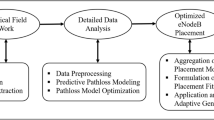Abstract
Designing cost-effective telecommunications networks often involves solving several challenging, interdependent combinatorial optimization problems simultaneously. For example, it may be necessary to select a least-cost subset of locations (network nodes) to serve as hubs where traffic is to be aggregated and switched; optimally assign other nodes to these hubs, meaning that the traffic entering the network at these nodes will be routed to the assigned hubs while respecting capacity constraints on the links; and optimally choose the types of links to be used in interconnecting the nodes and hubs based on the capacities and costs associated with each link type. Each of these three combinatorial optimization problems must be solved while taking into account its impacts on the other two. This paper introduces a genetic algorithm (GA) approach that has proved effective in designing networks for carrying personal communications services (PCS) traffic. The key innovation is to represent information about hub locations and their interconnections as two parts of a chromosome, so that solutions to both aspects of the problem evolve in parallel toward a globally optimal solution. This approach allows realistic problems that take 4–10 hours to solve via a more conventional branch-and-bound heuristic to be solved in 30–35 seconds. Applied to a real network design problem provided as a test case by Cox California PCS, the heuristics successfully identified a design 10% less expensive than the best previously known design. Cox California PCS has adopted the heuristic results and plans to incorporate network optimization in its future network designs and requests for proposals.
Similar content being viewed by others
References
CPLEX Version 4.0, Incline Village, NV, USA: CPLEX Optimization, Inc.
Davis, L. (1991).Handbook of Genetic Algorithms. New York: Van Nostrand Reinhold.
Holland, J. H. (1975).Adaptation in Natural and Artificial Systems. Ann Arbor, MI: University of Michigan Press.
Meyers, J. (1996). “Wireless for the 21st century,”Telephony: PCS Edge. Supplement toTelephony. August 5.
Osman, I. H., and J. P.Kelly. (1996).Meta-Heuristics: Theory and Applications. Boston, MA: Kluwer.
Rappoport, T. S. (1996).Wireless Communications: Principles and Practice. Prentice Hall.
Runyon, L. J., P. Wuh, M. Ching, C. McFadden, A. Quinton. (1996).Wireless in the United States: The Next Generation—March, 1996. Merrill Lynch research report.
Steuernagel, R. (1993).Cellular Marketing. Mendocino, CA: Quantum Publishing.
Taha, H. A. (1975).Integer Programming: Theory, Applications, and Computations. New York: Academic Press.
Author information
Authors and Affiliations
Rights and permissions
About this article
Cite this article
Cox, L.A., Davis, L., Lu, L.L. et al. Reducing costs of backhaul networks for PCS networks using genetic algorithms. J Heuristics 2, 201–216 (1997). https://doi.org/10.1007/BF00127357
Issue Date:
DOI: https://doi.org/10.1007/BF00127357




